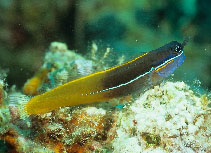| Family: |
Blenniidae (Combtooth blennies), subfamily: Salariinae |
| Max. size: |
6 cm TL (male/unsexed) |
| Environment: |
demersal; marine; depth range 1 - 10 m |
| Distribution: |
Western Central Pacific: Philippines and Borneo. |
| Diagnosis: |
Has a distinctive blue-white line below the eye that usually continues over the axil to above the anus on the body, bordered by a bright orange one below over the gill section. Head deep blue, continuing and gradually changing on the body to bright orange on the tail (Ref. 48636). |
| Biology: |
Adults inhabit seaward and sheltered reefs (Ref. 90102). They occur in coral rich habitats at about 10 m depth, usually among Acropora branches (Ref. 48636). Oviparous. Eggs are demersal and adhesive (Ref. 205), and are attached to the substrate via a filamentous, adhesive pad or pedestal (Ref. 94114). Larvae are planktonic, often found in shallow, coastal waters (Ref. 94114). |
| IUCN Red List Status: |
Vulnerable (VU); Date assessed: 24 March 2009 (D2) Ref. (130435)
|
| Threat to humans: |
harmless |
Source and more info: www.fishbase.org. For personal, classroom, and other internal use only. Not for publication.

